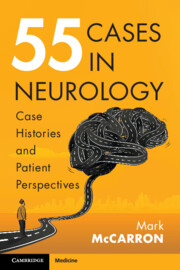Book contents
- 55 Cases in Neurology
- 55 Cases in Neurology
- Copyright page
- Contents
- Preface
- Acknowledgements
- Section 1 Visual Disturbance
- Section 2 Headache and Pain
- Case 10 Losing Volume
- Case 11 Where Is the Pus?
- Case 12 Recurrent Acute Headaches
- Case 13 A ‘Never’ Recurring Event
- Case 14 Headache and Fever
- Case 15 Brain Infection
- Case 16 Headache and Droopy Eye
- Case 17 Facial Somatic Mosaicism
- Case 18 An Alarm Clock Headache
- Section 3 Weakness
- Section 4 Behavioural and Language Changes
- Section 5 Confusion
- Section 6 Movement Disturbances
- Section 7 Acute Onset of Neurological Symptoms
- Index
- Plate Section (PDF Only)
- References
Case 12 - Recurrent Acute Headaches
from Section 2 - Headache and Pain
Published online by Cambridge University Press: 27 July 2023
- 55 Cases in Neurology
- 55 Cases in Neurology
- Copyright page
- Contents
- Preface
- Acknowledgements
- Section 1 Visual Disturbance
- Section 2 Headache and Pain
- Case 10 Losing Volume
- Case 11 Where Is the Pus?
- Case 12 Recurrent Acute Headaches
- Case 13 A ‘Never’ Recurring Event
- Case 14 Headache and Fever
- Case 15 Brain Infection
- Case 16 Headache and Droopy Eye
- Case 17 Facial Somatic Mosaicism
- Case 18 An Alarm Clock Headache
- Section 3 Weakness
- Section 4 Behavioural and Language Changes
- Section 5 Confusion
- Section 6 Movement Disturbances
- Section 7 Acute Onset of Neurological Symptoms
- Index
- Plate Section (PDF Only)
- References
Summary
A 59-year-old woman developed symptoms of a chest infection. She had not taken any medication for this. She woke at midnight and felt that she had to cough as she felt that she had choked. She had a burning chest pain radiating into her arms and head. A severe headache developed but became worse throughout the night, particularly when she repeatedly coughed. She was nauseated. Ten hours after headache onset, she was admitted to hospital. There her headache worsened, with at least three separate thunderclap exacerbations. Attempted defecation also worsened the headache. Prior to this episode, she had no history of headache.
- Type
- Chapter
- Information
- 55 Cases in NeurologyCase Histories and Patient Perspectives, pp. 79 - 84Publisher: Cambridge University PressPrint publication year: 2023



